Understanding the Ecological Footprint of Solar Energy Systems
Solar energy systems, touted as eco-friendly alternatives to conventional power sources, inherently bear their own ecological footprint. Often overlooked, this footprint encompasses the entire life cycle of solar panels – from the mining of raw materials, manufacturing, transportation, installation, maintenance, to eventual disposal. Whilst solar energy is renewable and releases no emissions during operation, its entire life cycle is not devoid of environmental implications.
The production of solar panels involves intensive industrial processes that contribute to carbon emissions and other pollutants. The mining of quartz, a primary ingredient in solar panels, calls for vast energy consumption. Post mining, the conversion of quartz into metallurgical-grade silicon and then into solar-grade silicon is another energy-intensive process. The manufacturing of solar panels also uses hazardous materials like sulfur hexafluoride, which has a global warming potential vastly exceeding that of carbon dioxide. Thus, despite the clean energy they produce, the production phase scar the ecological integrity of solar energy systems.
- The transportation of solar panels also adds to the ecological footprint, as it often involves long-distance shipping. Solar panel components are sourced from different parts of the world and then assembled at a central location. This necessitates extensive logistics networks that rely heavily on fossil fuels for operation, thereby contributing to global greenhouse gas emissions.
- Installation of solar energy systems can have local environmental impacts. For instance, large-scale solar farms require significant land area which could disrupt local ecosystems and lead to habitat loss for certain species. Additionally, improper installation practices may result in soil erosion or water contamination.
- Maintenance activities throughout the lifespan of a solar energy system can further impact the environment negatively. Cleaning processes often use chemicals that could potentially harm surrounding ecosystems if not properly managed. Furthermore, replacing faulty components contributes additional waste materials into our environment.
- Lastly, disposal represents another key aspect of a solar panel’s ecological footprint. While many components are recyclable, others such as glass and plastic present recycling challenges due to their mixed composition or lack of recycling facilities willing to accept them.
In conclusion, while undoubtedly an important part of transitioning towards sustainable energy sources, it is essential not to overlook the environmental implications associated with each stage in the life cycle of a solar power system – from production through disposal.
To truly harness its potential as an eco-friendly alternative:
- Efforts should be made towards developing greener manufacturing methods.
- More environmentally friendly transport solutions need exploring.
- Best practices must be implemented during installation and maintenance stages.
- Comprehensive end-of-life management strategies including effective recycling programs should be put in place for old or damaged panels.
By acknowledging and addressing these issues proactively we can ensure that our shift toward renewable energies like solar doesn’t inadvertently exacerbate other environmental problems but instead contributes positively towards achieving true sustainability goals
The Life Cycle Assessment of Solar Panels
 Examining the life cycle of solar panels involves a comprehensive understanding of all phases starting from raw material extraction to end-of-life disposal. This process is crucial as it enables stakeholders to identify potential environmental impacts at different stages. Initially, the production phase requires extraction and refining of quartz sand for silicon, one of the core constituents of a solar panel.
Examining the life cycle of solar panels involves a comprehensive understanding of all phases starting from raw material extraction to end-of-life disposal. This process is crucial as it enables stakeholders to identify potential environmental impacts at different stages. Initially, the production phase requires extraction and refining of quartz sand for silicon, one of the core constituents of a solar panel.
This process has implications for energy consumption and greenhouse gas emissions. Other components require rare earth metals like indium and gallium whose extraction can lead to environmental degradation and resource depletion issues.
In the use phase, solar panels create renewable energy without emitting harmful substances that contribute to global warming. They provide a cleaner, more sustainable alternative to fossil fuels for electricity generation. However, their impact on land use and potential interference with local ecosystems cannot be overlooked. Furthermore, solar panels have a finite lifespan, typically 25-30 years. The end-of-life stage covers the disposal or recycling of these deprecated systems. With the rapid growth in solar energy systems, managing the increasing volume of spent solar panels has become a significant environmental issue that needs urgent attention.
The life cycle assessment of solar panels can be broken down into the following stages:
- Raw Material Extraction: This involves mining and refining quartz sand for silicon, a key component in solar panels. The extraction process has notable implications on energy consumption and greenhouse gas emissions.
- Production Phase: Silicon is combined with other materials like silver, aluminum, and rare earth metals such as indium and gallium to create the photovoltaic cells that make up a solar panel. These processes can lead to environmental degradation due to excessive mining activities.
- Use Phase: Once installed, solar panels generate renewable energy without releasing harmful substances into the environment. They serve as an eco-friendly alternative to fossil fuels for electricity generation. However, their installation can impact land use patterns and potentially disrupt local ecosystems.
- End-of-Life Stage: Solar panels have a limited lifespan (usually 25-30 years), after which they need disposal or recycling. As the usage of solar power systems increases globally, managing end-of-life products becomes an important environmental concern requiring immediate action.
In conclusion, while solar panels are seen as a green technology solution for reducing carbon footprints and mitigating climate change effects, it’s essential to consider all aspects of their lifecycle from production through disposal or recycling. By doing so we ensure that our shift towards renewable energy sources does not inadvertently lead to new forms of environmental damage.
Assessing the Carbon Footprint of Solar Power Production
Solar power has been acclaimed as a clean and green energy source, but like all forms of energy, it has a carbon footprint. Though often overshadowed by the impacts of fossil fuels, the emissions generated during the life cycle of solar power production require scrutiny. The carbon footprint of solar energy hinges on an array of factors including manufacturing processes, transportation, installation, maintenance, and end-of-life disposal.
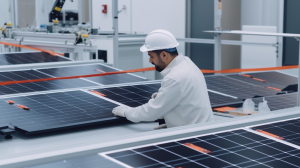 Manufacturing processes form a significant portion of a solar panel’s carbon footprint.
Manufacturing processes form a significant portion of a solar panel’s carbon footprint.
Extraction of raw materials like quartz and silver, their refinement to pure silicon or conductive cells, and assembling these elements into a functional panel all involve energy-intensive procedures.
Additionally, the nature of the globalized supply chain contributes to the carbon footprints as the transportation of components and finished products necessitate fossil fuel combustion. Installation and maintenance operations also add to the total emissions. Furthermore, the end-of-life disposal of solar panels can produce waste that, if not adequately managed, emits harmful greenhouse gases. Thus, while solar energy is a promising alternative to traditional fossil fuels, it is vital to recognize and address its carbon footprint for a genuine transition to sustainable energy.
- The manufacturing process of solar panels is a significant contributor to its carbon footprint. This involves:
◦ Extraction of raw materials: Mining activities for quartz and silver, both used in the production of solar panels, are energy-intensive and result in emissions.
◦ Refinement processes: Transforming these raw materials into pure silicon or conductive cells requires further energy input and results in additional emissions.
◦ Assembly: The assembly of these elements into a functional panel also demands energy, contributing to the overall carbon footprint. - Global supply chain factors play an important role as well. These include:
◦ Transportation: Both components and finished products need to be transported across various locations worldwide, requiring fossil fuel combustion which adds to the carbon footprint. - Installation and maintenance operations contribute towards total emissions. This includes:
◦ Energy required for installing the solar panels at desired locations.
◦ Regular maintenance activities that may involve transportation of workers or replacement parts. - End-of-life disposal management can lead to harmful greenhouse gas emissions if not properly managed. This refers to:
◦ Waste generated from decommissioned solar panels which needs careful handling and disposal methods.
In conclusion, while it’s clear that harnessing solar power has considerable benefits over traditional fossil fuels when it comes down to reducing our global CO2 output, acknowledging its own carbon footprints is crucial. Only by doing so can we ensure we’re truly making strides towards sustainable energy production – one where every stage of production is optimized for minimal environmental impact.
Solar Panel Manufacturing: A Deep Dive into its Environmental Influence
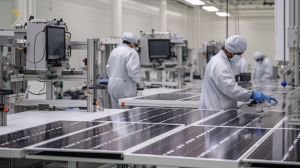 The process of manufacturing solar panels begins with sourcing raw materials, predominantly quartz. Quartz is then refined into silicon, which forms the foundational layer for every solar panel.
The process of manufacturing solar panels begins with sourcing raw materials, predominantly quartz. Quartz is then refined into silicon, which forms the foundational layer for every solar panel.
This refining process is energy-intensive and, in turn, leaves a substantial carbon footprint.
Additionally, hazardous materials such as sodium hydroxide and hydrochloric acid are used in this process, intensive handling and disposal of which can pose environmental risks.
Further environmental influence stems from the thinning and doping processes, in which harmful chemical vapors are emitted. Significant energy is also consumed during the crystallization of silicon and the subsequent transformation into wafers. At each phase of manufacturing, from sourcing materials to crystallization, the potential for environmental harm exists. Critical attention must be paid to lessen the negative ecological impact without compromising the efficiency and conversion rates of the resulting solar panels.
In the final stages of production, solar panels are assembled and tested. This process requires additional energy input, further adding to the carbon footprint of solar panel manufacturing. However, this environmental impact must be weighed against the long-term benefits of harnessing renewable solar energy.
- The sourcing phase involves procuring raw materials like quartz that is refined into silicon for use in solar panels.
◦ This refining process consumes a significant amount of energy and leaves a substantial carbon footprint.
◦ Hazardous chemicals such as sodium hydroxide and hydrochloric acid are used during refinement, posing potential environmental risks if not properly handled or disposed of. - The thinning and doping processes emit harmful chemical vapors which can have detrimental effects on air quality.
◦ These processes also consume considerable amounts of energy. - During crystallization, silicon is transformed into wafers – another high-energy-consuming step with its own potential for environmental harm.
- Solar panel assembly and testing require more energy inputs, contributing to an overall large carbon footprint from manufacturing alone.
While these points highlight some negative aspects associated with solar panel manufacturing’s ecological influence, it’s essential to remember that once operational; these systems generate clean electricity over their 25-30 year lifespan. Furthermore, advances in technology continue to reduce the environmental impacts associated with each stage of production. It remains vital for manufacturers to prioritize sustainability efforts throughout their operations while continuing research towards more environmentally friendly alternatives within this burgeoning industry.
Land Use and Habitat Disruption: A hidden Cost of Solar Energy
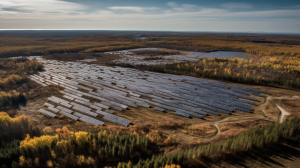 Large-scale solar installations require expansive tracts of land, which can have significant ecological impacts. One of the often overlooked costs of solar energy is the potential for habitat disruption. This occurs when installations are sited in areas that are crucial to local wildlife, presenting issues of habitat fragmentation and potential decline in biodiversity.
Large-scale solar installations require expansive tracts of land, which can have significant ecological impacts. One of the often overlooked costs of solar energy is the potential for habitat disruption. This occurs when installations are sited in areas that are crucial to local wildlife, presenting issues of habitat fragmentation and potential decline in biodiversity.
Although solar farms can be installed on rooftops or used lands such as brownfields and landfills, this is not always practical or feasible. In some cases, pristine lands have to be cleared to make room for solar installations.
Moreover, the process of transforming an area to accommodate a solar farm often involves clearing vegetation and smoothing the terrain, which can lead to habitat destruction for ground-dwelling species. It may bring about alteration of local hydrological patterns, which could have far-reaching impacts on the surrounding ecosystems, including increased erosion rates and reduced groundwater recharge. It is important that these potential environmental consequences are thoughtfully considered in the site selection and design process for solar installations.
- To ensure that the environmental impact of solar installations is minimized, it is crucial to conduct thorough site assessments before construction begins. These should include evaluations of local wildlife populations and habitats, as well as potential impacts on hydrological patterns and soil erosion rates.
- Land use planning strategies can also play a key role in mitigating habitat disruption caused by solar farms. For example, locating installations in areas with low biodiversity or installing panels on previously developed land can help to reduce the overall ecological footprint of these projects.
- Solar developers must also consider the long-term effects of their projects on local ecosystems. This includes the potential for habitat fragmentation – when large, contiguous habitats are broken up into smaller, isolated patches due to human activities – which can have serious implications for species survival and biodiversity.
- In addition to these considerations, there are a number of mitigation strategies that can be employed during the construction and operation phases of solar projects. These may include measures such as using wildlife-friendly fencing around installations, implementing erosion control practices during construction work, or restoring native vegetation post-construction wherever possible.
- Lastly but importantly; public policies aimed at promoting renewable energy sources like solar power need to strike a balance between encouraging development and protecting natural resources. It’s essential that regulators take into account not only economic factors but also environmental considerations like habitat disruption when approving new solar projects.
In conclusion; while transitioning towards more sustainable forms of energy production such as solar power is necessary for combating climate change; it’s equally important we do so responsibly by minimizing any negative impacts on our natural environment including disruptions to wildlife habitats.
Water Consumption in Solar Power Generation: An Overlooked Aspect
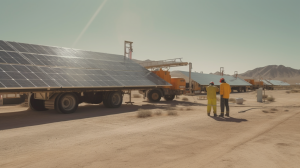 While water consumption for solar power generation might not have the same level of public awareness as carbon emissions in relation to energy production, it is nevertheless an important ecological perspective. Solar power technologies, especially the Concentrated Solar Power (CSP) systems that involve the use of water for cooling purposes, represent a significant source of water consumption.
While water consumption for solar power generation might not have the same level of public awareness as carbon emissions in relation to energy production, it is nevertheless an important ecological perspective. Solar power technologies, especially the Concentrated Solar Power (CSP) systems that involve the use of water for cooling purposes, represent a significant source of water consumption.
The CSP technology, which generates power by using mirrors or lenses to concentrate a large area of sunlight, requires water for cooling the steam that drives the turbines. With burgeoning demand for electricity and increasing reliance on solar power, it becomes essential to consider the water implications of this renewable energy technology.
Furthermore, photovoltaic solar panels, another typical type of solar energy system, involve water-intensive processes during their manufacturing phase. Silicon purification, wafer production, and cell fabrication processes in the manufacturing of photovoltaic solar panels demand substantial volumes of water. While the operational stage of these panels imply a minimal water footprint, further scrutiny is required to ascertain the entire life cycle water usage. Addressing these water consumption aspects is critical in ensuring the sustainable scaling of solar energy systems, especially considering the escalating global water stress scenarios.
- Concentrated Solar Power Systems: These systems use mirrors or lenses to concentrate a large area of sunlight onto a small area. The concentrated light is then used as heat, which produces steam that drives the turbines in power plants. This process requires substantial quantities of water for cooling purposes.
- Photovoltaic Solar Panels: The manufacturing phase of these panels involves silicon purification, wafer production, and cell fabrication processes – all of which are water-intensive. Although their operational stage implies minimal water usage, it’s crucial to consider the entire life cycle’s water footprint.
- Water Stress Scenarios: With increasing global populations and industrial requirements leading to escalating demand for freshwater resources, there is an urgent need to address the issue of high-water consumption related to solar energy technologies.
- Need for Sustainable Solutions: It becomes essential not only to promote renewable sources like solar energy but also ensure that its adoption does not exacerbate existing environmental challenges such as water scarcity.
- Policy Implications and Recommendations: Policymakers should strive towards encouraging technological advancements that reduce the amount of water used in CSP systems and photovoltaic panel manufacturing processes. Additionally, they must also work on regulations ensuring responsible management of available resources during both production and operation stages.
In conclusion, while solar power offers significant advantages over traditional fossil fuel-based methods by reducing carbon emissions substantially, its associated high-water consumption cannot be overlooked. As we transition towards cleaner forms of energy generation under sustainable development goals set out by international bodies like UNDP (United Nations Development Programme), it becomes imperative that we adopt comprehensive approaches considering all aspects – including efficient utilization and conservation measures concerning critical resources like water.
Solar Panel Disposal and Recycling: Environmental Concerns
 Significant attention is often garnered towards the benefits of solar energy, specifically, its potential for reducing carbon emissions and reliance on fossil fuels.
Significant attention is often garnered towards the benefits of solar energy, specifically, its potential for reducing carbon emissions and reliance on fossil fuels.
However, it’s crucial to recognize that solar panel disposal and recycling pose several environmental concerns that are often overlooked.
After their useful lifespan of 25-30 years, solar panels become waste material, and given the rapid adoption of solar energy worldwide, the magnitude of waste is set to increase dramatically. This waste contains hazardous materials that could leach into the soil and water if not handled appropriately, raising serious environmental and public health challenges.
Moreover, many existing recycling processes for solar panels remain inefficient, requiring energy-intensive and expensive methods. These processes are not only environmentally unsound but also produce various hazardous waste byproducts. The poor economics of solar panel recycling is another deterrent. Often, the cost of recycling exceeds the potential recoverable value from the materials, leading to stockpiling or dumping of solar panels in landfills. This paradox brings to light the urgent need for the development of advanced recycling technologies that are environmentally friendly and economically viable to avert potential future crises.
- Solar panels become waste material after their useful lifespan of 25-30 years. With the increasing adoption of solar energy, this waste is set to multiply exponentially.
- The disposal of these used solar panels can lead to hazardous materials leaching into soil and water if not managed properly, posing serious environmental and public health challenges.
- Current recycling processes for solar panels are inefficient, often requiring energy-intensive methods that are environmentally unsound.
- These recycling procedures also produce various forms of hazardous waste byproducts further contributing to environmental pollution.
- The economics behind solar panel recycling is another issue. Often times, the cost associated with recycling exceeds the potential recoverable value from the materials contained in the panels themselves. This imbalance leads to stockpiling or dumping of old solar panels in landfills.
- This situation highlights an urgent need for advanced, efficient recycling technologies which are both environmentally friendly and economically viable.
The issues surrounding solar panel disposal and recycling underscore a broader challenge: how do we balance our pursuit for clean energy with sustainable end-of-life management? As we continue down this path towards renewable sources like solar power, it’s crucial that we address these concerns head-on through research, innovation and policy changes aimed at improving existing practices while minimizing negative impacts on our environment.
Analyzing the Impact of Solar Farms on Local Ecosystems
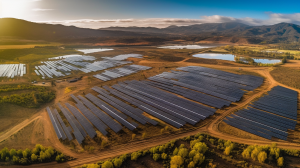 Solar farms, extensively seen as a green energy solution, have undisputed benefits. However, their impact on local ecosystems often gets overshadowed by the pressing need to mitigate climate change. Like any infrastructure development, large scale solar plants also have some negative impacts that should be scrutinized and mitigated whenever possible.
Solar farms, extensively seen as a green energy solution, have undisputed benefits. However, their impact on local ecosystems often gets overshadowed by the pressing need to mitigate climate change. Like any infrastructure development, large scale solar plants also have some negative impacts that should be scrutinized and mitigated whenever possible.
Presence of solar farms can lead to changes in land use patterns, potentially causing habitat disruption for local flora and fauna. Thus it is important to fully understand the ecological implications of the development before installing a solar farm.
Large-scale solar farms typically require a significant expanse of land. This conversion can affect ground-nesting birds, small mammals and some types of insects that rely on vegetation. Furthermore, the effects are not contained within the farm boundaries. Adjacent areas may also be impacted due to changes in runoff patterns or heat island effects. Nothing exists in isolation in nature, so when one part of an ecosystem changes, it will invariably have a ripple effect throughout the system. Therein lies the dilemma – while we make strides forward harnessing the sun’s energy, we must also tread carefully to minimize the ecological footprint of such developments.
The impact of solar farms on local ecosystems can be categorized into several key areas:
- Changes in Land Use: The construction of large-scale solar farms often involves significant changes to land use patterns. This could include the removal of vegetation, which serves as a habitat for various species.
- Impact on Ground-Nesting Birds: These birds rely heavily on ground cover for nesting and protection from predators. The clearing of land for solar farm installation may disrupt their habitats, leading to potential population declines.
- Impact on Small Mammals and Insects: Similarly, small mammals and certain types of insects that depend upon vegetation could also see their habitats disrupted or destroyed by changes in land use.
- Runoff Patterns Alteration: Solar farms might alter runoff patterns due to the extensive hard surfaces they introduce. This change can affect nearby water bodies, potentially impacting aquatic life forms.
- Increased Risk of Flooding: If not properly managed, altered runoff could lead to increased risk of flooding in adjacent areas.
- Water Quality Degradation: Changes in runoff might carry pollutants into local waterways affecting water quality and thus aquatic lifeforms.
- Heat Island Effects: Large arrays of solar panels can create localized microclimates known as heat islands.
- Temperature Fluctuations: These heat islands may cause temperature fluctuations that are harmful to local wildlife.
- Altered Weather Patterns : Over time these heat islands might even influence local weather patterns causing unforeseen ecological impacts.
In conclusion, while harnessing renewable energy sources like the sun is vital for our planet’s future sustainability; it’s equally important we do so responsibly with minimal disruption to existing ecosystems. Comprehensive environmental impact assessments should always be carried out prior to establishment any large scale infrastructure projects including solar farms.
Comparative Analysis of Solar Energy and Traditional Fossil Fuels
In terms of environmental impact, the divide between solar energy and traditional fossil fuels is distinctive. The extraction and combustion of fossil fuels like coal, oil, and natural gas cause significant harm to the environment. The most notable damages include air and water pollution, which cause a myriad of health issues, ecosystem disruption, and contribute heavily to global climate change. Moreover, the processes involved are not sustainable, as we continuously deplete these finite resources, creating a mode of energy consumption that is untenable in the long run.
On the flip side, solar energy holds a clean and sustainable profile. Solar energy systems generate electricity without releasing harmful pollutants into the environment, leading to better air quality and contributing towards reducing global carbon emissions. Harnessing this resource does not result in the depletion of a finite source, as the sun’s energy is essentially inexhaustible on a human timescale. Furthermore, once the initial carbon footprint of manufacturing and installation is offset, solar panels continue to produce clean energy throughout their lifespan with negligible emissions. However, it is important to note that the manufacturing process, land usage, and end-of-life treatment of solar panels also carry environmental implications that should not be overlooked.
- Solar energy has minimal environmental impact compared to traditional fossil fuels. It does not contribute to air and water pollution, which are significant issues associated with the extraction and combustion of fossil fuels.
- The use of coal, oil, and natural gas as energy sources is unsustainable in the long term due to their finite nature. Continuous depletion of these resources creates a mode of energy consumption that cannot be maintained indefinitely.
- Fossil fuel usage contributes significantly to global climate change through substantial carbon emissions.
On the other hand:
- Solar energy systems generate electricity without releasing harmful pollutants into the environment. This leads to better air quality overall and helps reduce global carbon emissions.
- Unlike fossil fuels, solar power harnesses an inexhaustible source – the sun’s energy. Therefore it offers a sustainable solution for our growing energy needs.
- Once offsetting its initial manufacturing and installation carbon footprint, solar panels continue producing clean energy throughout their lifespan with negligible emissions.
However:
- There are also environmental considerations related to solar power that should not be overlooked:
◦ The manufacturing process for creating solar panels can have negative impacts on the environment if not responsibly managed
◦ Land usage for large-scale solar farms could potentially disrupt local ecosystems or compete with agricultural land use
◦ End-of-life treatment of used or damaged solar panels presents challenges in terms of recycling or disposal procedures
What is the ecological footprint of solar energy systems?
The ecological footprint of solar energy systems refers to the environmental impact caused by the extraction, production, use, and disposal of solar panels. This includes factors like the amount of raw material required, the energy used in manufacturing, and the waste generated at the end of the panel’s life.
How is the life cycle assessment of solar panels conducted?
The life cycle assessment of solar panels is conducted by evaluating every stage of a panel’s life from raw material extraction, through production and use, to end-of-life disposal. This process helps in understanding the overall environmental impact of solar panels.
How can we measure the carbon footprint of solar power production?
The carbon footprint of solar power production can be measured by calculating the total amount of greenhouse gas emissions produced during the life cycle of the solar panel, including manufacturing, installation, maintenance, and decommissioning.
How does solar panel manufacturing influence the environment?
Solar panel manufacturing can impact the environment in several ways. It requires the extraction of raw materials and the use of energy, which can lead to emissions, waste generation, and significant water consumption.
Why is land use and habitat disruption a hidden cost of solar energy?
Land use and habitat disruption is often overlooked when considering the environmental impact of solar energy. Large-scale solar farms require significant amounts of land, which can lead to habitat destruction and displacement of local wildlife.
How is water used in solar power generation?
Water is used mainly in the manufacturing process of solar panels. It’s used for cooling, rinsing, and in various chemical processes. However, compared to traditional fossil fuels, solar power generation uses significantly less water.
What are the environmental concerns related to solar panel disposal and recycling?
Solar panels contain potentially hazardous materials like lead and cadmium. If not properly disposed of or recycled, these materials can leach into the environment, posing significant risks.
How do solar farms influence local ecosystems?
Solar farms can influence local ecosystems by altering land use patterns, causing habitat destruction, and displacing local wildlife. However, with proper planning and mitigation strategies, these impacts can be minimized.
How does the impact of solar energy compare to traditional fossil fuels?
While solar energy does have some environmental impacts, they are generally lower than those of traditional fossil fuels. Solar power emits significantly less greenhouse gases, uses less water, and doesn’t result in air or water pollution that is associated with the extraction and burning of fossil fuels.

Sanela Isakov
Sanela is a passionate advocate for environmentally conscious living. With a background in environmental science, she brings a wealth of knowledge to our community, inspiring readers to make sustainable choices in their daily lives. Join Sanela on a journey toward a greener, more sustainable future.


